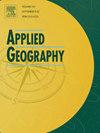Assessing the legacy of redlining on spatial inequities in social and environmental determinants of health
IF 5.4
2区 地球科学
Q1 GEOGRAPHY
引用次数: 0
Abstract
Although housing discrimination was outlawed in the United States in 1968, historic redlining remains a driver of racialized inequities in environmental health. However, there are many aspects of environmental health that are not yet well-understood in relation to redlining. We investigated the legacy of redlining on social and environmental determinants of health and the spatial distribution of these relationships across Baltimore and Philadelphia. We use publicly available spatial data sources on sociodemographics, built environment, housing, mobility, and arrests to understand the distribution of determinants of health given historic redlining. Multiscale geographically weighted regression was implemented to measure the relationship between these dimensions and redlining grades. While we identified strong, spatially heterogenous relationships between redlining and social and environmental determinants of health, for nearly all determinants of health, we observed the most adverse characteristics in “C” tracts, indicating a yellow-lining effect. Meanwhile, redlined tracts in both cities exhibited a mix of built environment characteristics, including higher levels of walkability, housing density, renter-occupied housing, and vacancies. Our findings suggest that while redlining has played a role in shaping neighborhood conditions, other factors, such as ongoing disinvestment and neighborhood transformation processes are likely influential in determining current social and environmental determinants of health.
评估在健康的社会和环境决定因素方面的空间不平等问题上划红线的遗留问题
尽管住房歧视在1968年就在美国被定为非法,但历史性的划分仍然是环境卫生方面种族化不平等的一个驱动因素。然而,环境卫生的许多方面还没有很好地理解与划红线有关的问题。我们调查了巴尔的摩和费城对健康的社会和环境决定因素以及这些关系的空间分布的影响。我们使用社会人口统计、建筑环境、住房、流动性和逮捕等公开可用的空间数据源,以了解在历史红线的情况下健康决定因素的分布。采用多尺度地理加权回归来衡量这些维度与红线等级之间的关系。虽然我们发现红线与健康的社会和环境决定因素之间存在强烈的空间异质性关系,但对于几乎所有健康决定因素,我们观察到“C”区最不利的特征,表明黄线效应。与此同时,这两个城市的红线区域显示了建筑环境特征的混合,包括更高水平的可步行性、住房密度、租房者居住和空置率。我们的研究结果表明,虽然红线在塑造社区条件方面发挥了作用,但其他因素,如正在进行的撤资和社区转型过程,可能对确定当前健康的社会和环境决定因素产生影响。
本文章由计算机程序翻译,如有差异,请以英文原文为准。
求助全文
约1分钟内获得全文
求助全文
来源期刊

Applied Geography
GEOGRAPHY-
CiteScore
8.00
自引率
2.00%
发文量
134
期刊介绍:
Applied Geography is a journal devoted to the publication of research which utilizes geographic approaches (human, physical, nature-society and GIScience) to resolve human problems that have a spatial dimension. These problems may be related to the assessment, management and allocation of the world physical and/or human resources. The underlying rationale of the journal is that only through a clear understanding of the relevant societal, physical, and coupled natural-humans systems can we resolve such problems. Papers are invited on any theme involving the application of geographical theory and methodology in the resolution of human problems.
 求助内容:
求助内容: 应助结果提醒方式:
应助结果提醒方式:


